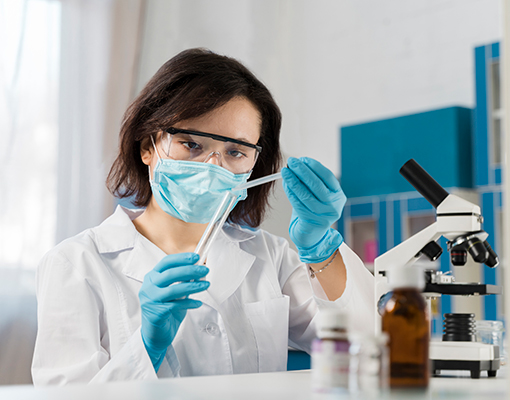5-alpha dihydrotestosterone (DHT) testing is conducted to measure the levels of this hormone in the body. DHT is a potent androgen derived from testosterone through the action of the enzyme 5-alpha reductase. It plays several important roles in both men and women:
1. **In Men:**
- **Development of Male Sexual Characteristics:** DHT is crucial for the development and maintenance of male reproductive tissues, such as the prostate gland and seminal vesicles.
- **Androgenic Effects:** It is more potent than testosterone in its androgenic effects, contributing to the development of secondary sexual characteristics like facial hair growth and deepening of the voice.
- **Hair Follicle Sensitivity:** DHT is implicated in male pattern baldness (androgenetic alopecia), as it binds to receptors in hair follicles, causing them to shrink over time.
2. **In Women:**
- **Androgen Excess Disorders:** Elevated DHT levels can contribute to symptoms of hyperandrogenism in women, such as hirsutism (excessive body hair growth), acne, and menstrual irregularities.
- **Fertility Issues:** DHT imbalance can affect ovarian function and fertility.
### Reasons for 5-alpha Dihydrotestosterone Testing:
- **Diagnosis of Androgen-related Disorders:** Testing DHT levels helps diagnose conditions like androgenetic alopecia, hirsutism, and disorders of sexual development.
- **Evaluation of Prostate Health:** In men, DHT levels may be measured to assess prostate function and evaluate conditions such as benign prostatic hyperplasia (BPH) or prostate cancer.
- **Monitoring Hormonal Therapies:** DHT levels may be monitored in individuals undergoing hormone replacement therapy (HRT), especially in cases where DHT levels need to be controlled, such as in transgender hormone therapy.
- **Research Purposes:** DHT testing is also used in research to understand the role of androgens in various physiological processes and diseases.
### Procedure:
- **Blood Sample Collection:** Similar to other hormone tests, DHT testing involves drawing a blood sample, usually from a vein in the arm.
### Clinical Significance:
By measuring DHT levels, healthcare providers can better understand hormonal imbalances and their implications for reproductive health, sexual development, and overall well-being. This information guides diagnosis, treatment decisions, and ongoing management of conditions associated with androgen excess or deficiency.
5-alpha dihydrotestosterone (DHT) is a potent androgen hormone derived from testosterone through the action of the enzyme 5-alpha reductase. It plays crucial roles in various physiological processes, primarily in males but also impacting females to a lesser extent.
### Functions of 5-alpha DHT:
1. **Development of Male Sexual Characteristics**:
- **Genital Development**: During fetal development, DHT is responsible for the differentiation and growth of the male genitalia.
- **Secondary Sexual Characteristics**: DHT is more potent than testosterone in promoting the development of secondary sexual characteristics in males, including facial and body hair growth, deepening of the voice, and growth of the prostate gland.
2. **Androgenic Effects**:
- DHT binds more strongly to androgen receptors in target tissues compared to testosterone, making it more effective in exerting androgenic effects.
3. **Contribution to Androgen-related Disorders**:
- **Androgenetic Alopecia**: DHT is implicated in male pattern baldness (androgenetic alopecia), where it causes hair follicles to shrink and eventually cease producing hair.
- **Prostate Growth**: DHT stimulates the growth of the prostate gland, and elevated levels can contribute to benign prostatic hyperplasia (BPH), a condition characterized by prostate enlargement.
### Clinical Applications of 5-alpha DHT Testing:
- **Diagnosis of Androgen-related Disorders**:
- **Androgenetic Alopecia**: Testing DHT levels helps diagnose and monitor male pattern baldness.
- **Benign Prostatic Hyperplasia (BPH)**: Elevated DHT levels can contribute to prostate enlargement, a common condition in aging men.
- **Evaluation of Virilization**:
- In women, excessive DHT production can lead to symptoms of virilization, such as hirsutism (excessive body hair growth), acne, and male-pattern baldness.
### Procedure:
5-alpha DHT testing involves measuring the concentration of DHT in the blood or sometimes in urine samples. The procedure typically includes:
- **Blood or Urine Sample Collection**: A healthcare provider collects a sample, usually from a vein in the arm or through urine collection.
- **Laboratory Analysis**: The sample undergoes analysis to quantify the level of DHT present, often reported in nanograms per deciliter (ng/dL) or picomoles per liter (pmol/L).
### Clinical Significance:
Measuring 5-alpha DHT levels is essential in diagnosing and managing conditions related to androgen excess or deficiency. It provides valuable insights into the role of DHT in hair loss, prostate health, and overall androgenic activity. By assessing DHT levels, healthcare providers can tailor treatment strategies, such as medications that inhibit 5-alpha reductase or therapies aimed at mitigating the effects of androgen excess, to improve patient outcomes and quality of life.
Service Coverage Area
We provide blood tests in Noida, Gurgaon, Faridabad, Delhi, Indirapuram, Ghaziabad,
Greater Noida, and Greater Noida Extension(west).










